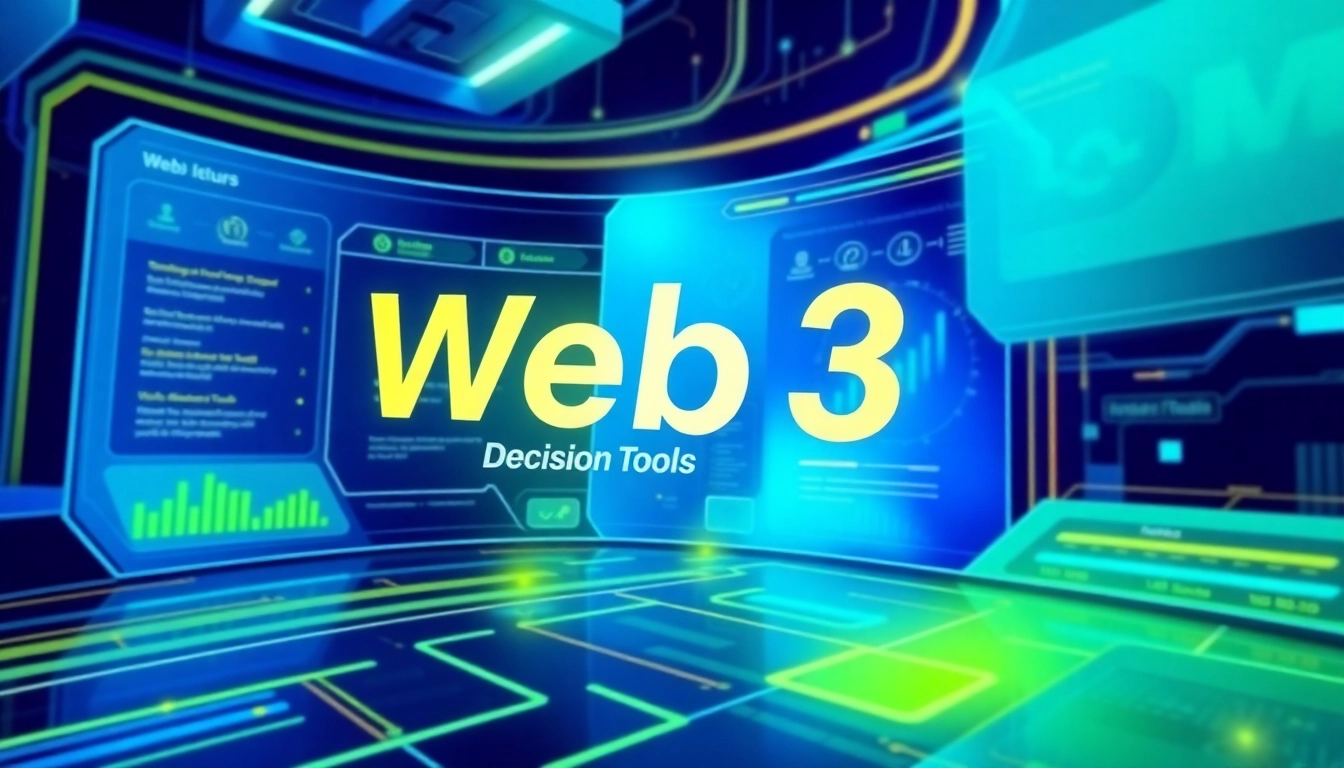Understanding Web3 Decision Tools
In the rapidly evolving landscape of online interactions and business processes, decision-making frameworks have undergone a significant transformation. As organizations embrace Web3 technologies, they must equip themselves with decision tools that can harness the full potential of decentralization and blockchain innovations. Web3 decision tools enable businesses to navigate through complex data environments, enhance governance, and leverage collective intelligence. This article delves deep into the construct of Web3 decision tools, their importance, and their capacity to reshape how decisions are made in decentralized platforms.
What are Web3 Decision Tools?
Web3 decision tools refer to a suite of applications and platforms that facilitate decision-making processes on decentralized systems. Unlike traditional tools that rely on centralized databases and governance structures, Web3 decision tools utilize blockchain technology, smart contracts, and decentralized networks to empower users in their decision-making endeavors.
These tools are designed to provide insights, enable collaboration, and foster transparent practices that align with the core tenets of Web3—transparency, security, and decentralization. They come in various forms, including data analysis platforms, decision-making frameworks, and governance systems that help organizations move past traditional barriers.
The Importance of Decentralization
Decentralization stands as a cornerstone of Web3 technologies. Unlike the conventional centralized systems, which are often prone to monopolistic control and opacity, decentralized systems distribute authority and ensure that all stakeholders have a say in the decision-making processes.
One of the most significant advantages of decentralization is the empowerment of community members. By enabling peer-to-peer interactions and participatory governance, organizations can build trust with their stakeholders. Additionally, decentralization mitigates single points of failure, enhances resilience, and supports an open innovation culture.
Key Features and Benefits
- Transparency: All decisions made using Web3 decision tools are recorded on public ledgers, providing an audit trail that builds trust.
- Security: Utilizing cryptographic methods ensures that data is secure from unauthorized access and tampering.
- Cost efficiency: By automating processes through smart contracts, organizations can reduce transaction costs and operational overhead.
- Collaboration: Users can collaborate in real-time, leveraging collective knowledge and expertise for better decision-making outcomes.
- Scalability: Many Web3 decision tools are built to handle varying levels of demand, making them suitable for both small projects and large-scale deployments.
Types of Web3 Decision Tools
Data Analysis Tools in Web3
Data analysis tools within the Web3 ecosystem allow organizations to collect, process, and visualize data from decentralized networks. These tools provide businesses with valuable insights derived from real-time data, enabling informed decisions about product development, marketing strategies, and resource allocation.
Key data analysis features often include predictive analytics, machine learning algorithms, and interactive dashboards that display trends and patterns. These tools can perform deep dives into transaction records, user behavior, and market dynamics, which are pivotal in emerging ecosystems.
Governance and Voting Mechanisms
Web3 decision tools also encompass governance frameworks that facilitate collective decision-making among stakeholders. Blockchain-based voting mechanisms enable secure and transparent voting processes that protect the integrity of outcomes.
These mechanisms often implement token-based voting systems where stakeholders can cast votes proportional to their stake in the network. Additionally, proposals can be evaluated based on community input prior to final decision-making, ensuring that the processes are democratic and inclusive.
Integrating AI with Web3 Decision Tools
The integration of artificial intelligence (AI) with Web3 decision tools represents a significant advancement in decision support systems. AI can analyze vast amounts of decentralized data swiftly and accurately, identifying patterns and insights that may be invisible to human analysts.
Organizations can leverage AI-driven predictive models to foresee the implications of their decisions within the Web3 space. Furthermore, by using natural language processing, AI can facilitate more intuitive interactions with these tools, making them accessible even to users without a technical background.
Common Challenges in Implementing Web3 Decision Tools
Technical Barriers and Solutions
Implementing Web3 decision tools is not without its challenges. Technical barriers often arise due to the complexity of blockchain technology and the decentralized architecture inherent in Web3. Organizations may struggle with integrating these tools into existing infrastructures or may lack the technical expertise needed to utilize them effectively.
To overcome these barriers, organizations should consider investing in training programs for their teams, as well as seeking partnerships with experienced Web3 developers. Additionally, tools that offer compatibility with conventional software solutions can ease the transition and enhance adoption.
User Adoption Issues
Another significant challenge is user adoption. For many users, especially those accustomed to traditional decision-making frameworks, the shift to decentralized tools can be daunting. Concerns around usability and complexity can deter stakeholders from engaging fully with Web3 decision tools.
To improve user adoption rates, organizations can focus on enhancing user interfaces and ensuring that the tools are user-friendly. Offering comprehensive onboarding programs and continuous support also plays a crucial role in making the transition smooth for users.
Data Privacy and Security Concerns
While decentralization enhances security, it also raises new data privacy concerns. Organizations must navigate the thin line between transparency and confidentiality, ensuring that sensitive data remains protected while still adhering to the principles of openness that Web3 promotes.
To address this issue, implementing robust encryption techniques and adhering to best practices in data handling are essential. Organizations should also be transparent with users about data usage policies, thereby building trust and ensuring compliance with regulations such as GDPR.
Best Practices for Utilizing Web3 Decision Tools
Identifying Your Specific Needs
Before adopting Web3 decision tools, organizations should conduct a thorough analysis to identify their specific needs. Understanding the unique challenges, workflows, and objectives will enable businesses to choose tools that align with their goals and operational strategies.
Conducting stakeholder interviews, leveraging surveys, and analyzing existing processes can provide valuable insights into what features and capabilities are necessary for successful implementation.
Integrating Tools into Existing Systems
Integrating Web3 decision tools into existing systems is crucial for maximizing their effectiveness. Organizations should strive for interoperability, ensuring that new tools can seamlessly work with legacy systems and data sources. This integration can reduce the risk of data silos and enhance the quality of the insights generated by decentralized frameworks.
Employing APIs (Application Programming Interfaces) to facilitate communication between various systems can aid in achieving this level of integration. Furthermore, a phased approach to deployment can allow for a smoother transition, minimizing disruptions to ongoing operations.
Training and Onboarding Users Effectively
The success of Web3 decision tools heavily relies on how well users are trained and onboarded. Developing comprehensive training materials that cater to different user levels—from beginners to advanced users—is essential. Interactive tutorials, webinars, and hands-on workshops can enhance user engagement and facilitate a deeper understanding of the tools.
Encouraging a culture of feedback also plays a significant role in ongoing training efforts. Regularly soliciting user input on their experiences can help identify areas for improvement and lead to iterative upgrades of training resources.
Measuring Success with Web3 Decision Tools
Key Performance Indicators (KPIs) to Track
To evaluate the effectiveness of Web3 decision tools, organizations must establish clear Key Performance Indicators (KPIs). Tracking metrics such as user engagement rates, decision-making speed, and the quality of outcomes can provide insights into how well the tools are performing.
Additionally, organizations should consider measuring cost savings, return on investment (ROI), and stakeholder satisfaction to gain a holistic view of the value derived from these tools. Regular reviews of these KPIs can help identify trends and areas that require further attention.
Analyzing User Feedback and Iterations
User feedback is invaluable in the iterative process of refining Web3 decision tools. Organizations should implement mechanisms for gathering feedback—such as surveys, interviews, and usability tests—to ensure that tools are meeting user needs.
Analyzing this feedback can lead to actionable insights that inform updates and enhancements to the tools, ensuring they evolve alongside user expectations and technological advancements.
Adapting to Changes in Web3 Technology
The Web3 landscape is ever-changing, and organizations must stay agile and adaptable in their approach to decision-making tools. Keeping abreast of emerging technologies, regulatory changes, and best practices will empower businesses to adjust their strategies as needed.
Engaging with communities, attending relevant conferences, and participating in Web3 discussions can help organizations remain informed and ensure they’re leveraging the latest advancements in the space.














Leave a Reply